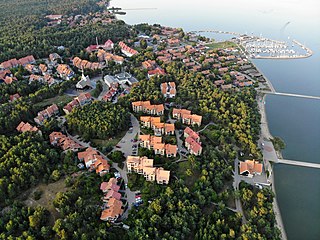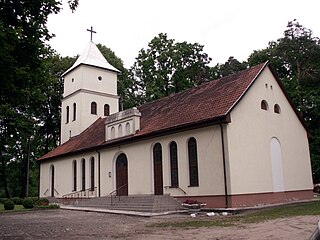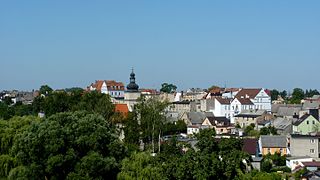
Kaliningrad Oblast is the westernmost federal subject of the Russian Federation, in Central and Eastern Europe. It is a semi-exclave situated on the Baltic Sea. The oblast is surrounded by two European Union and NATO members: Poland to the south and Lithuania to the north and east. The largest city and administrative centre of the province (oblast) is the city of Kaliningrad, formerly known as Königsberg. Half of the population of the oblast lives in Kaliningrad City proper. The port city of Baltiysk is Russia's only port on the Baltic Sea that remains ice-free in winter. Kaliningrad Oblast had a population of roughly 1 million in the Russian Census of 2021. The area of Kaliningrad oblast is 15,125 square kilometers.

East Prussia was a province of the Kingdom of Prussia from 1772 to 1829 and again from 1878 ; following World War I it formed part of the Weimar Republic's Free State of Prussia, until 1945. Its capital city was Königsberg. East Prussia was the main part of the region of Prussia along the southeastern Baltic Coast.

Klaipėda, historically also Memel, is a city in Lithuania on the Baltic Sea coast. It is the third largest city in Lithuania, the fifth largest city in the Baltic States and the capital of Klaipėda County, as well as the only major seaport in the country.

Warmian–Masurian Voivodeship is a voivodeship (province) in northeastern Poland. Its capital and largest city is Olsztyn. The voivodeship has an area of 24,192 km2 (9,341 sq mi) and in 2019 had a population of 1,425,967.

The Neman,Niemen or Nẽmunas is a river in Europe that rises in central Belarus and flows through Lithuania then forms the northern border of Kaliningrad Oblast, Russia's western exclave, which specifically follows its southern channel. It drains into the Curonian Lagoon, narrowly connected to the Baltic Sea. The 937 km (582 mi) long Neman is a major Eastern European river. It flows generally west to Grodno within 12 kilometres (7.5 mi) of the Polish border, north to Kaunas, then westward again to the sea.

Nida is a resort town in Lithuania, the administrative centre of Neringa municipality. Located on the Curonian Spit between the Curonian Lagoon and the Baltic Sea, it is the westernmost point of Lithuania and the Baltic states, close to the border with the Russian Kaliningrad Oblast exclave. It currently has about 2,385 residents.

The Klaipėda Region or Memel Territory was defined by the 1919 Treaty of Versailles in 1920 and refers to the northernmost part of the German province of East Prussia, when, as Memelland, it was put under the administration of the Entente's Council of Ambassadors. The Memel Territory, together with other areas severed from Germany, was to remain under the control of the League of Nations until a future date, when the people of these regions would be allowed to vote on whether the land would return to Germany or not. Today, the former Memel Territory is controlled by Lithuania as part of Klaipėda and Tauragė counties.

Lithuania Minor or Prussian Lithuania is a historical ethnographic region of Prussia, where Prussian Lithuanians lived, now located in Lithuania and the Kaliningrad Oblast of Russia. Lithuania Minor encompassed the northeastern part of the region and got its name from the territory's substantial Lithuanian-speaking population. Prior to the invasion of the Teutonic Knights in the 13th century, the main part of the territory later known as Lithuania Minor was inhabited by the tribes of Skalvians and Nadruvians. The land depopulated during the incessant war between Lithuania and the Teutonic Order. The war ended with the Treaty of Melno and the land was repopulated by Lithuanian newcomers, returning refugees, and the remaining indigenous Baltic peoples; the term Lithuania Minor appeared for the first time between 1517 and 1526.

Šilutė is a city in the south of the Klaipėda County in western Lithuania. The city was part of the Klaipėda Region and ethnographic Lithuania Minor. Šilutė was the interwar capital of Šilutė County and is currently the capital of Šilutė District Municipality.

Juodkrantė is a Lithuanian seaside resort town located on the Curonian Spit with a permanent population of about 720 people. A part of Neringa municipality, Juodkrantė is the second largest settlement on Lithuania's part of the spit. For centuries it was a fishing village, which underwent a tourist boom in the late 19th–early 20th century.

Pagėgiai is a town in south-western Lithuania. It is located in the medieval region of Scalovia in the historic region of Lithuania Minor. It is the capital of Pagėgiai municipality, and as such it is part of Tauragė County.

The Act of Tilsit was an act, signed in Tilsit by 24 members of the National Council of Lithuania Minor on November 30, 1918. Signatories demanded unification of Lithuania Minor and Lithuania Proper into a single Lithuanian state. This would mean detaching the northern areas of East Prussia, inhabited by Prussian Lithuanians, from the German Empire.

Sępólno Krajeńskiepronounced[sɛmˈpulnɔkraˈjɛɲskʲɛ] is a town in northern Poland, in the Kuyavian-Pomeranian Voivodeship. It is the capital of Sępólno County and Gmina Sępólno Krajeńskie.

The Evangelical Lutheran Church in Lithuania is a Lutheran church body comprising congregations in Lithuania. The ELCL is a member of the Porvoo Communion and the Lutheran World Federation.

The Prussian Lithuanians, or Lietuvininkai, are Lithuanians, originally Lithuanian language speakers, who formerly inhabited a territory in northeastern East Prussia called Prussian Lithuania, or Lithuania Minor, instead of the Grand Duchy of Lithuania and, later, the Republic of Lithuania. Prussian Lithuanians contributed greatly to the development of written Lithuanian, which for a long time was considerably more widespread and in more literary use in Lithuania Minor than in Lithuania proper.

Ernst Alexander August George Wichert was a German lawyer, judge, and author.

Kintai is a small town in Klaipėda County, in Lithuania. It is the center of the Eldership (Seniūnija) Kintai and is part of the Šilutė District Municipality. According to the 2011 census, the town has a population of 616 people.

Žemaičių Naumiestis is a town in Klaipėda county, Šilutė district municipality in western Lithuania, between Klaipėda and Kaliningrad Oblast. The rivers Šustis, Šelmuo and Lendra flow through it.

Herbert Kurt Böttcher was a German lawyer, and chief of police of Memel and Kassel. He was also an SS-Brigadeführer and Generalmajor of police who served as the last SS and Police Leader in Radom during the Second World War. After the war, he was tried and executed for Holocaust-related crimes.

Germany–Lithuania relations are the bilateral relations between Germany and Lithuania. The formal diplomatic relations existed from 1918 to 1944 and again since 1991. Both countries are members of the Council of the Baltic Sea States, the Organization for Security and Cooperation in Europe (OSCE), OECD, the Council of Europe, NATO and the European Union. Lithuania has also been part of the Eurozone since 2015. The relationship is described as close and reliable partnership. Germany gave full support to Lithuania's applications for membership in the European Union and NATO.
























